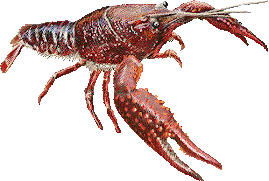The profitability of redclaw aquaculture has been assessed using a model or hypothetical farm, with data gathered from several farms and two pilot-scale commercial farms established jointly by the participating farmer and DPI.
The model involves a farm size of 40 x 1000 sq.m growout ponds and 7 x 1000 sq.m juvenile production ponds, representing a total pond area of 4.7 hectares.
Previous analysis (Hinton, 1994) suggested that a production area of approximately four hectares was the minimum for commercial viability of a stand alone redclaw farm.
The financial evaluation was undertaken using a discounted cash flow technique. Discounting was used to allow for the timing of the costs and benefits for the life of the enterprise which was assumed to be 20 years (Johnston and Jones, 2001).
The model farm was assumed to annually harvest 394 kilograms of redclaw per growout pond from year two onwards.
Redclaw were estimated to take nine months to reach the acceptable market size of 65 g mean weight. At this weight the farmgate price was estimated to be AUD13.50 per kilogram.
Initial establishment of the model farm was estimated to cost AUD347,900. Included in this cost were land, hired labour, machinery and all farm infrastructure costs.
Specifications for the farm layout and pond characteristics were based on 'best practice' recommendations (Jones and Ruscoe, 1996).
Redclaw aquaculture was profitable based on the model farm.
Using the model farm yield and price, the farm profit was AUD5.25 per kilogram each year. The total costs of production were estimated to be AUD 8.25 per kilogram each year. Included in this cost were all operating costs, capital costs and allowance for the owner's labour and management.
The discounted payback period, which represents the time to recover the initial outlay, was four years.
Sensitivity analyses for prices and yield showed that, at the annual yield of 394 kilograms per growout pond, the minimum price for the investment to be profitable was AUD8.25 per kilogram.
Similarly, at the assumed price of AUD13.50 per kilogram, the minimum annual yield required to be profitable was 232 kilogram per growout pond.
Growout periods may vary between 6 months and 15 months depending on the redclaw market weight the grower intends selling.
Redclaw market weights and price were assumed to increase with longer turnoff periods.
Based on a sensitivity analysis which compared various growout periods, the most profitable option was nine months.
The least profitable turnoff period was 12 months. The results from this analysis were very sensitive to prices, survival rates and market weights.
Survival rates and market weights are strongly correlated to farm management expertise.
Results from established farms applying best practice techniques confirm that the economics of the model are a true and accurate representation of commercial redclaw aquaculture.
Monday, September 14, 2009
Subscribe to:
Post Comments (Atom)





No comments:
Post a Comment